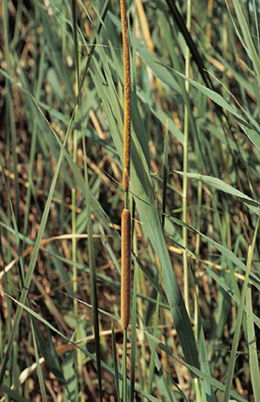

Cattail may be the aquatic plant in Job.
THE ARID MIDDLE EAST DOES NOT usually conjure up images of cattails, because they are commonly associated with wetlands. But at least one species of cattail is widespread in the region and may be mentioned in the Old Testament: “Under the lotus plant [tse’el] he lies, hidden among the reeds [qaneh]. The lotuses conceal him in their shadow; the poplars by the stream surround him” (Job 40:21–22, NIV). The King James Version translates the beginning of verse 21 as “under the shady [tse’el] trees [’ets].” This description of the behemoth includes its riverine habitat. It is unfortunate that NIV translators used “lotus plant” in this verse. Lotus is the common name applied to water lilies, most often Nelumbo lutea. But it is also the Latin name of a genus of legumes, Lotus, and species of this genus are not aquatic plants. Why is this mysterious plant linked with the likewise enigmatic behemoth?
Tse’el can mean many things, including “stalk” or “stick,” in any case implying something slender. This could hardly be Nelumbo, which has large, round, usually floating leaves up to 1 meter (3 feet) across. A tall, slender, stick-like plant could be giant cane or common reed, both of which would fit here, except that qaneh is used later in the same verse. Papyrus could conceivably fit the description, except that in Job 8:11, the word achuw is translated “papyrus.”
Could this mysterious plant be one of the other aquatic plants in the Middle East? In the context of Job 40, the plant should have the following features: forms a stand dense enough to hide the behemoth; grows in a stream that might flood; be part of a guild that includes poplars, possibly Populus alba; and be a plant compatible with vegetation found along the Jordan River (alluded to in verse 23).

These cattails are growing along the Zara River in the Jordan Valley.
Of plants found under such conditions, the most likely is Typha domingensis, which is known in English as cattail. It forms dense stands and has long, narrow, vertical leaves that would be within the circumscription of the Hebrew word for something slender. The thick, heavy rhizomes can withstand flooding, and cattail is a common plant in the Jordan Valley, a region of high soil salinity, which this species can tolerate.
Whatever plant might be indicated in the Old Testament, the cattail is widespread in the eastern Mediterranean region and would be known to authors of the Bible texts.